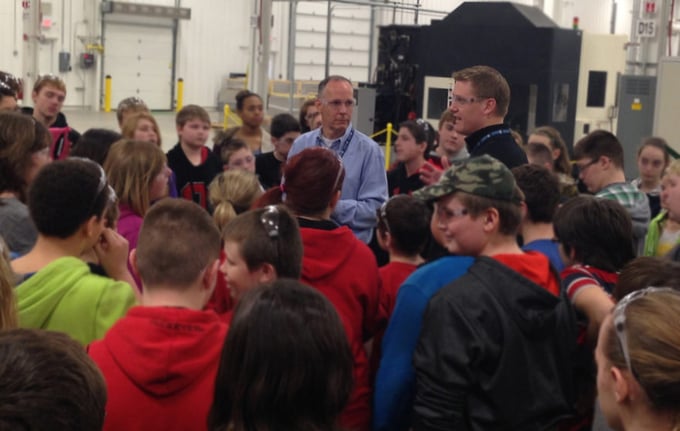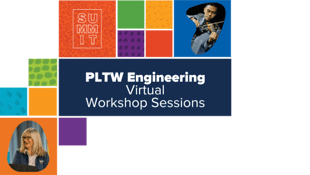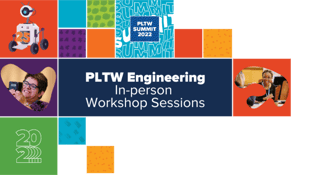Steve Stokey is executive vice president at Allied Machine & Engineering in Dover, Ohio.
About a decade ago, I got involved in what I think is a unique way to create an impassioned and skilled local engineering and technical workforce. The Project Lead The Way (PLTW) program we established in our small county in northeast Ohio has become a renowned model for encouraging homegrown talent to pursue careers in science, technology, engineering, and/or math (STEM) fields.
Read on to see how we are making it work and to hear from one young participant who says it changed his life.
Searching for a Way to Encourage Local Students to Become Engineers
It all started after a candidate rejected an excellent engineering job at Allied Machine & Engineering due to unwillingness to relocate to Dover, Ohio. Our manufacturing factory is in Tuscarawas County, on the edge of Appalachia in northeast Ohio. It is a beautiful area but not a destination location for a career or the typical go-to place for a young college graduate looking for a big city or a beach.
We have always worked with local vocational schools and have tried to hire local precision machining students. We also had some success working with community and technical colleges but were not able to entice students to come back after they left to get four-year engineering degrees. Also, we found that very few high school students were even pursuing engineering degrees. Clearly, we were failing to communicate that an engineering degree can offer a rewarding career with a great standard of living.
I knew that in order for our local businesses to grow, we had to change the way we trained for the game. I knew we had students who grew up in the area and loved it here. They may have wanted to return home after college graduation but felt their opportunities would be limited in a small town. We needed a way to develop engineers and technicians with the complete spectrum of skills – including a good work ethic, integrity, and the aptitude for continuous learning. From an engineering standpoint, we were looking for employees with either an associate or bachelor’s degree. For technicians, we needed people who would be able to repair equipment or perform hands-on applications on the shop floor as well as in the marketplace.
As a serious Cleveland Indians fan, I came to believe that our quest was similar to the one that team owner Dick Jacobs faced in the mid-1980s. After purchasing the Indians, he invested heavily in a farm team to develop homegrown talent that could compete in the big league – and the investment worked. By the 1990s, his team had won division championships and was competing in playoffs and the World Series. (No more wisecracks by David Letterman about the team’s abysmal record!) So, my goal was to find those talented young people who would help build our own farm team.
Enter Project Lead The Way
There are great job opportunities in the area, but you must be properly conditioned and trained for them. I wondered how we could prepare our kids for the engineering opportunities right here in their backyard. How could we strengthen the future of our community and local businesses by getting our youth excited about STEM?
On the day I got the rejection from the engineering job candidate, it was a lucky coincidence that a PLTW flyer happened to be sitting on my desk.
PLTW is a nonprofit organization dedicated to empowering students to thrive in their education and careers. The nonprofit offers K-12 curricular and teacher training programs in the areas of computer science, engineering, and biomedical science.
In Ohio, there are more than 300 active PLTW programs at the high school level. These programs, combined with traditional mathematics and science courses, introduce students to the scope, rigor, and disciplines of computer science, engineering, and/or biomedical science prior to entering college. PLTW also has programs for middle and elementary school students that help them understand STEM concepts and develop critical-thinking skills.
I was intrigued by the notion of strengthening students’ skills so they could take advantage of STEM opportunities in our area, so I picked up the phone and called the number on the flyer. Once I made that fateful call, I was quickly enlisted as chair of the local PLTW Project Implementation Task Force, a group of community business and education members.
Not long after, the task force met with all the superintendents of Tuscarawas County school districts and told them about the program goals. We explained if they could commit to implementing PLTW in their district, the business members would find the resources to run the program. Six out of nine districts agreed, and we were on our way to establishing our own locally run program.
The Tuscarawas County program partnered with Ohio’s local coalition of PLTW partners, who know the academic side and speak the education language. The beauty of the arrangement is that it is truly plug and play. The group leaned heavily on the educator group to walk the business community through the process and explain how to integrate the program into the school system. The superintendents focused on building understanding among teachers and finding teachers who would be interested in being trained to teach the courses.
I brought my passion and belief in our local talent to the game and was excited to become the chief fundraiser. Along with Allied, other local business partners, foundations, and grants contributed more than $700,000 to launch the program and purchase equipment and technology needed to run the program, such as robotics equipment and computers to run CAD software. In nine years, the program has raised well over $1.5 million – pretty impressive for a small Ohio county with less than a hundred thousand people.
Tuscarawas County PLTW programs touch all grade levels. The elementary curriculum introduces K-5 students to the fundamentals of STEM. Middle school students engage in the PLTW Gateway program, which offers 10 units for use in an existing science class or as stand-alone enrichment classes. Examples of units include Design and Modeling, Automation and Robotics, Magic of Electrons, and Medical Detectives. At the high school level, students can choose from courses in computer science, engineering, and biomedical science pathways.
The high school PLTW Engineering course offerings – an example of a rigorous program guaranteed to start building the homegrown talent we were scouting for – are outlined below:
- Introduction to Engineering Design
- Principles of Engineering
- Aerospace Engineering
- Civil Engineering and Architecture
- Computer Integrated Manufacturing
- Computer Science Principles
- Digital Electronics
- Environmental Sustainability
- Engineering Design and Development (Capstone)
The program is strength training for young minds, but the benefits of developing the game plan expand beyond the classroom’s playing field. Numerous teachers trained to instruct PLTW shared that the experience has changed their teaching careers. One said she had previously felt herself getting a bit stale, like she was just going through the motions. Teaching this curriculum and watching young minds explode as they learned to problem solve and build things had truly energized her.
As part of the PLTW program, hundreds of students have participated in field trips to the Allied manufacturing facilities. Tours are designed to show students that a modern manufacturing facility is not the dark, loud, and grungy place in which their grandparents may have worked.
Highlighting automation, robots, and computer-controlled machines, plant tours show everything from raw material to finished products. They begin the tour by walking through the engineering office to see products being created on a computer, and they end the tour by seeing the finished product. In addition, tours for high school-aged students include specific stations that cover phases of the process in greater detail, including engineering design and lean manufacturing principles. In this tour, the desktop “factory” makes widgets ineffectively, and students are asked to reorganize activities in order to improve productivity.
The tours help students develop their own view of manufacturing in the 21st century – with lights, robots, and technology bustling around in a bright, air-conditioned facility. After all, we want to teach students that engineers don’t just drive trains. We are committed to immersing youth in the manufacturing experience so they can witness STEM in action through these tours. We are passionate about developing the talent needed to keep American manufacturing on the forefront of the industry.
Showing It Off to the Community
One unique feature of Tuscarawas County PLTW programs is an annual showcase that gives students the opportunity to present their STEM projects to the community. Often donors to community endeavors do not get to see the end results of their generosity, and that is why I ask schools participating in PLTW to invite the community to this showcase each spring.
Over the years, the event has grown into a major affair and includes an open house before the presentations. Held at the Kent State University Tuscarawas Campus, the event is packed with parents and grandparents as well as business and community members. Visitors review the displays and ask students to explain their work. Last year, more than 150 students presented their own STEM projects at the annual PLTW showcase.
The showcase has become a real proving ground for creativity. For example, one student was standing in front of the room and demonstrating a coin sorter design. The team printed the coin sorters on a 3-D printer and said, “After the presentation, we’ll be in the back of the room selling them for $5 apiece.” Now that’s free enterprise – connecting engineering design ideas to retail sales. I paid the $5, and I remember those kids every time I reach in for a coin.
A few years ago, the showcase format expanded to introduce a little friendly competition. Each grade level competes with others in their grade. Engineers view the presentations and pick the best team. The trophies, which are five feet tall, can be brought back to the winning school for display for the year. They have become a huge source of school pride.
The Program Leads to Real Jobs
PLTW in Ohio has led to major successes in recruiting and hiring of program participants. One well-known success story is a partnership with Honda North America in Marysville. This partnership allows Columbus State students to study two days a week and spend the other three working at Honda. Many who complete the two-semester program and earn their associate degree are hired full time. PLTW students from Centerville and Kettering-Fairmont high schools have received intern assignments at Motoman/Yaskawa while continuing their education in a format similar to the Honda model. Other local programs include a job connection website called Home Town Opportunity, which focuses on connecting local companies with local talent, as well as the AMBE Alliance (Auglaize Mercer Business Education Alliance).
Allied Machine & Engineering does its part in hiring homegrown talent into our building, as well. Each summer, we bring in more than 30 student interns to introduce them to the high-skilled jobs available in today’s manufacturing sector. The interns are given the opportunity to earn money while getting entry-level experience. Those with the right skills receive a job offer prior to their senior year.
Homegrown Talent at Work
One great example of PLTW’s success is Logan Lamonica, who graduated from Dover High School in 2013 after taking PLTW classes throughout his high school career. Logan credits the PLTW program with introducing him to all areas of engineering so he could eventually pursue the one for which he had the most passion.
Logan graduated from Miami University in May 2017 with a bachelor’s degree in mechanical engineering. He interned at Allied in the summer of 2016 and just started working at Allied full time. Logan is serving as an R&D design engineer and works with a team of six engineers, brainstorming improvements for existing tools and creating new products. He creates 3-D models and performs Finite Element Analysis (FEA) to evaluate how the new tools compare to other ideas and existing products.
“PLTW introduces students to a wide variety of engineering skills, whether it is CAD, wiring circuits, soldering, writing G-Code, or just solving engineering problems on paper,” he explained. “Because of this, I was able to go into college with an advantage over my peers.”
He notes that most of his friends never had the chance to take any engineering classes before starting college, while he already had four years and an array of engineering skills by the time he arrived on campus.
“Throughout my college career, I’d find times where I was the only one in my group capable of performing a task,” he said. “I had a lot more knowledge of CAD and technical drawings than my peers, which always made me the designer for our projects. I was also a step ahead when I was involved in a project dealing with electrical engineering.”
I am proud to say that no other county in Ohio has been as successful at partnering with schools and the business community. This approach to grooming homegrown talent is batting a thousand.
PLTW’s blog is intended to serve as a forum for ideas and perspectives from across our network. The opinions expressed are those of each guest author.


